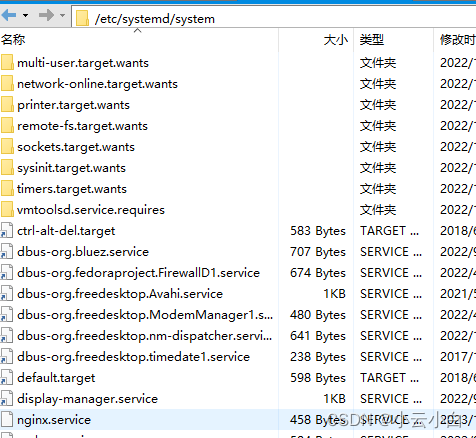一、安装nginx
1、安装依赖
yum install -y gcc-c++ pcre pcre-devel zlib zlib-devel openssl openssl-devel2、去官网下载最新的稳定版nginx
nginx: download![]() http://nginx.org/en/download.html
http://nginx.org/en/download.html

3、将下载后的nginx上传至/usr/local下
或者执行
#2023-10-8更新
cd /usr/local
wget http://nginx.org/download/nginx-1.24.0.tar.gz然后解压命令解压当当前路径
tar -xzvf nginx-1.24.0.tar.gz4、安装nginx
切换到解压的路径
cd /usr/local/nginx-1.24.0配置并制定安装路径 /usr/local/nginx 下
./configure --prefix=/usr/local/nginx --user=www --group=www --with-http_stub_status_module --with-http_ssl_module
执行安装,可能新系统提示没有make命令,输入y 继续安装执行即可;
make install编译后入下图,可执行命令查看nginx的文件目录
whereis nginx
切换路径并删除解压包
cd ..
rm -rf /usr/local/nginx-1.24.05、新建自启动脚本并上传
1)新建 nginx.service 文件
文件内容如下
[Unit]
Description=nginx-The High-performance HTTP Server
After=network.target[Service]
Type=forking
PIDFile=/usr/local/nginx/logs/nginx.pid
ExecStartPre=/usr/local/nginx/sbin/nginx -t -c /usr/local/nginx/conf/nginx.conf
ExecStart=/usr/local/nginx/sbin/nginx -c /usr/local/nginx/conf/nginx.conf
ExecReload=/usr/local/nginx/sbin/nginx -s reload
ExecStop=/usr/local/nginx/sbin/nginx -s stop
PrivateTmp=true[Install]
WantedBy=multi-user.target2)将文件上传至 /etc/systemd/system 下

3)新建nginx运行的用户组和用户:运行下列命令
groupadd -f www
useradd -g www www6、重载服务脚本,并加入自启动
#重新载入服务列表
systemctl daemon-reload
#启动nginx
systemctl start nginx.service
#将nginx加入自启动脚本
systemctl enable nginx.service
#查看nginx状态
systemctl status nginx.service可能用到命令
#重启nginx
systemctl restart nginx.service
#查看nginx状态
systemctl status nginx.service
7、测试自启动效果
1)运行 reboot 命令 重启并连接机器
重启后执行查看80端口占用
netstat -tlunp |grep 80![]()
2)放开80端口
firewall-cmd --zone=public --add-port=80/tcp --permanent
firewall-cmd --reload3)直接浏览器访问测试

二、配置nginx
下面是一个比较全的配置
# 以下是全局段配置
#user administrator administrators; #配置用户或者组,默认为nobody nobody。
#worker_processes 2; #设置进程数,默认为1
#pid /nginx/pid/nginx.pid; #指定nginx进程运行文件存放地址
error_log log/error.log debug; #制定日志路径,级别:debug|info|notice|warn|error|crit|alert|emerg
# events段配置信息
events {accept_mutex on; #设置网路连接序列化,防止惊群现象发生,默认为onmulti_accept on; #设置一个进程是否同时接受多个网络连接,默认为off#use epoll; #事件驱动模型,select|poll|kqueue|epoll|resig|/dev/poll|eventportworker_connections 1024; #最大连接数,默认为512
}
# http、配置请求信息
http {include mime.types; #文件扩展名与文件类型映射表default_type application/octet-stream; #默认文件类型,默认为text/plain#access_log off; #取消服务日志 log_format myFormat '$remote_addr–$remote_user [$time_local] $request $status $body_bytes_sent $http_referer $http_user_agent $http_x_forwarded_for'; #自定义格式access_log log/access.log myFormat; #combined为日志格式的默认值sendfile on; #允许sendfile方式传输文件,默认为off,可以在http块,server块,location块。sendfile_max_chunk 100k; #每个进程每次调用传输数量不能大于设定的值,默认为0,即不设上限。keepalive_timeout 65; #连接超时时间,默认为75s,可以在http,server,location块。upstream mysvr { server 127.0.0.1:7878;server 192.168.10.121:3333 backup; #热备}error_page 404 https://www.baidu.com; #错误页# 第一个Server区块开始,表示一个独立的虚拟主机站点server {keepalive_requests 120; #单连接请求上限次数。listen 4545; #监听端口server_name 127.0.0.1; #监听地址 location ~*^.+$ { #请求的url过滤,正则匹配,~为区分大小写,~*为不区分大小写。#root path; #根目录#index vv.txt; #设置默认页proxy_pass http://mysvr; #请求转向mysvr 定义的服务器列表deny 127.0.0.1; #拒绝的ipallow 172.18.5.54; #允许的ip } }
}

)















——点击拍照到存入相册)
